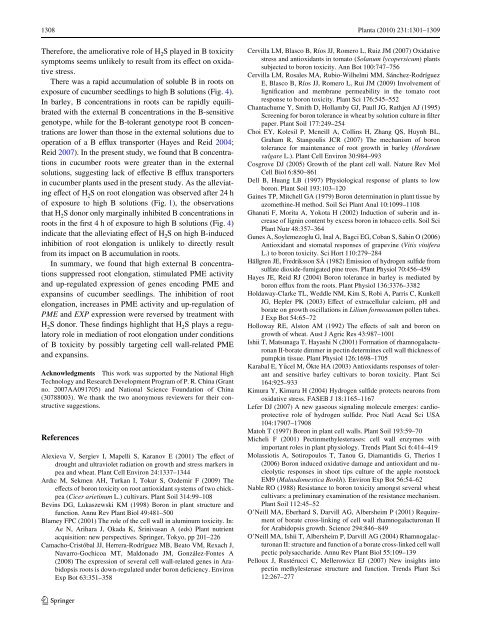(Cucumis sativus L.) seedlings
(Cucumis sativus L.) seedlings
(Cucumis sativus L.) seedlings
Create successful ePaper yourself
Turn your PDF publications into a flip-book with our unique Google optimized e-Paper software.
1308 Planta (2010) 231:1301–1309Therefore, the ameliorative role of H 2 S played in B toxicitysymptoms seems unlikely to result from its eVect on oxidativestress.There was a rapid accumulation of soluble B in roots onexposure of cucumber <strong>seedlings</strong> to high B solutions (Fig. 4).In barley, B concentrations in roots can be rapidly equilibratedwith the external B concentrations in the B-sensitivegenotype, while for the B-tolerant genotype root B concentrationsare lower than those in the external solutions due tooperation of a B eZux transporter (Hayes and Reid 2004;Reid 2007). In the present study, we found that B concentrationsin cucumber roots were greater than in the externalsolutions, suggesting lack of eVective B eZux transportersin cucumber plants used in the present study. As the alleviatingeVect of H 2 S on root elongation was observed after 24 hof exposure to high B solutions (Fig. 1), the observationsthat H 2 S donor only marginally inhibited B concentrations inroots in the Wrst 4 h of exposure to high B solutions (Fig. 4)indicate that the alleviating eVect of H 2 S on high B-inducedinhibition of root elongation is unlikely to directly resultfrom its impact on B accumulation in roots.In summary, we found that high external B concentrationssuppressed root elongation, stimulated PME activityand up-regulated expression of genes encoding PME andexpansins of cucumber <strong>seedlings</strong>. The inhibition of rootelongation, increases in PME activity and up-regulation ofPME and EXP expression were reversed by treatment withH 2 S donor. These Wndings highlight that H 2 S plays a regulatoryrole in mediation of root elongation under conditionsof B toxicity by possibly targeting cell wall-related PMEand expansins.Acknowledgments This work was supported by the National HighTechnology and Research Development Program of P. R. China (Grantno. 2007AA091705) and National Science Foundation of China(30788003). We thank the two anonymous reviewers for their constructivesuggestions.ReferencesAlexieva V, Sergiev I, Mapelli S, Karanov E (2001) The eVect ofdrought and ultraviolet radiation on growth and stress markers inpea and wheat. Plant Cell Environ 24:1337–1344ArdÂc M, Sekmen AH, Turkan I, Tokur S, Ozdemir F (2009) TheeVects of boron toxicity on root antioxidant systems of two chickpea(Cicer arietinum L.) cultivars. Plant Soil 314:99–108Bevins DG, Lukaszewski KM (1998) Boron in plant structure andfunction. Annu Rev Plant Biol 49:481–500Blamey FPC (2001) The role of the cell wall in aluminum toxicity. In:Ae N, Arihara J, Okada K, Srinivasan A (eds) Plant nutrientacquisition: new perspectives. Springer, Tokyo, pp 201–226Camacho-Cristóbal JJ, Herrera-Rodríguez MB, Beato VM, Rexach J,Navarro-Gochicoa MT, Maldonado JM, González-Fontes A(2008) The expression of several cell wall-related genes in Arabidopsisroots is down-regulated under boron deWciency. EnvironExp Bot 63:351–358Cervilla LM, Blasco B, Ríos JJ, Romero L, Ruiz JM (2007) Oxidativestress and antioxidants in tomato (Solanum lycopersicum) plantssubjected to boron toxicity. Ann Bot 100:747–756Cervilla LM, Rosales MA, Rubio-Wilhelmi MM, Sánchez-RodríguezE, Blasco B, Ríos JJ, Romero L, Rui JM (2009) Involvement ofligniWcation and membrane permeability in the tomato rootresponse to boron toxicity. Plant Sci 176:545–552Chantachume Y, Smith D, Hollamby GJ, Paull JG, Rathjen AJ (1995)Screening for boron tolerance in wheat by solution culture in Wlterpaper. Plant Soil 177:249–254Choi EY, Kolesil P, Mcneill A, Collins H, Zhang QS, Huynh BL,Graham R, Stangoulis JCR (2007) The mechanism of borontolerance for maintenance of root growth in barley (Hordeumvulgare L.). Plant Cell Environ 30:984–993Cosgrove DJ (2005) Growth of the plant cell wall. Nature Rev MolCell Biol 6:850–861Dell B, Huang LB (1997) Physiological response of plants to lowboron. Plant Soil 193:103–120Gaines TP, Mitchell GA (1979) Boron determination in plant tissue byazomethine-H method. Soil Sci Plant Anal 10:1099–1108Ghanati F, Morita A, Yokota H (2002) Induction of suberin and increaseof lignin content by excess boron in tobacco cells. Soil SciPlant Nutr 48:357–364Gunes A, Soylemezoglu G, Inal A, Bagci EG, Coban S, Sahin O (2006)Antioxidant and stomatal responses of grapevine (Vitis viniferaL.) to boron toxicity. Sci Hort 110:279–284Hällgren JE, Fredriksson SÅ (1982) Emission of hydrogen sulWde fromsulfate dioxide-fumigated pine trees. Plant Physiol 70:456–459Hayes JE, Reid RJ (2004) Boron tolerance in barley is mediated byboron eZux from the roots. Plant Physiol 136:3376–3382Holdaway-Clarke TL, Weddle NM, Kim S, Robi A, Parris C, KunkellJG, Hepler PK (2003) EVect of extracellular calcium, pH andborate on growth oscillations in Lilium formosanum pollen tubes.J Exp Bot 54:65–72Holloway RE, Alston AM (1992) The eVects of salt and boron ongrowth of wheat. Aust J Agric Res 43:987–1001Ishii T, Matsunaga T, Hayashi N (2001) Formation of rhamnogalacturonanII-borate dimmer in pectin determines cell wall thickness ofpumpkin tissue. Plant Physiol 126:1698–1705Karabal E, Y:cel M, Ökte HA (2003) Antioxidants responses of tolerantand sensitive barley cultivars to boron toxicity. Plant Sci164:925–933Kimura Y, Kimura H (2004) Hydrogen sulWde protects neurons fromoxidative stress. FASEB J 18:1165–1167Lefer DJ (2007) A new gaseous signaling molecule emerges: cardioprotectiverole of hydrogen sulWde. Proc Natl Acad Sci USA104:17907–17908Matoh T (1997) Boron in plant cell walls. Plant Soil 193:59–70Micheli F (2001) Pectinmethylesterases: cell wall enzymes withimportant roles in plant physiology. Trends Plant Sci 6:414–419Molassiotis A, Sotiropoulos T, Tanou G, Diamantidis G, Therios I(2006) Boron induced oxidative damage and antioxidant and nucleolyticresponses in shoot tips culture of the apple rootstockEM9 (Malusdomestica Borkh). Environ Exp Bot 56:54–62Nable RO (1988) Resistance to boron toxicity amongst several wheatcultivars: a preliminary examination of the resistance mechanism.Plant Soil 112:45–52O’Neill MA, Eberhard S, Darvill AG, Albersheim P (2001) Requirementof borate cross-linking of cell wall rhamnogalacturonan IIfor Arabidopsis growth. Science 294:846–849O’Neill MA, Ishii T, Albersheim P, Darvill AG (2004) RhamnogalacturonanII: structure and function of a borate cross-linked cell wallpectic polysaccharide. Annu Rev Plant Biol 55:109–139Pelloux J, Rustérucci C, Mellerowicz EJ (2007) New insights intopectin methylesterase structure and function. Trends Plant Sci12:267–277123


